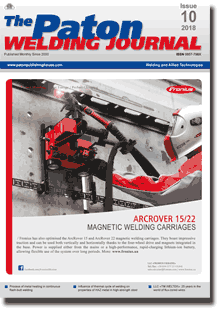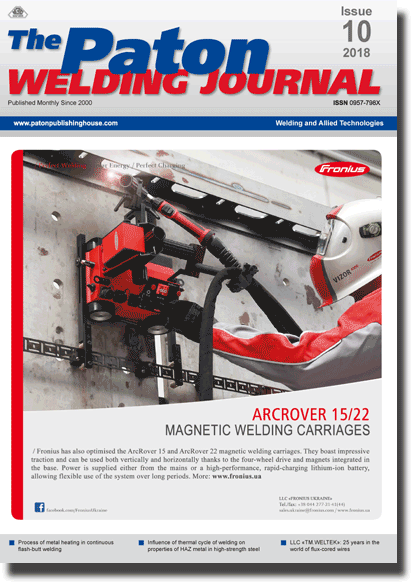| 2018 №10 (02) |
DOI of Article 10.15407/tpwj2018.10.03 |
2018 №10 (04) |

The Paton Welding Journal, 2018, #10, 14-21 pages
Effect of surface-active elements on the formation of solidification cracks
V.A. Anoshin and V.M. Ilyushenko
E.O. Paton Electric Welding Institute of the NAS of Ukraine 11 Kazimir Malevich Str., 03150, Kyiv, Ukraine. E-mail: office@paton.kiev.ua
Based on analysis of physicochemical properties of harmful impurities, the concepts of the mechanism of their effect on formation of solidification cracks in different metals are summarized, which consist, firstly, in enrichment of crystallite boundaries with them (residual liquid) at the last stages of solidification, and, secondly, in revealing the effect of adsorption-induced decrease of strength and ductility. The difference in the nature of solidification of single-phase and two-phase (with eutectic) alloys was established as regards enrichment of crystallite boundaries with harmful impurities. It is shown that the specific surface energy at solid metal – melt interface and on grain boundaries has the greatest effect on crack formation. It was established that also the surface-active alloying elements, characterized by the same physicochemical properties as harmful impurities, can influence the increased tendency to solidification cracking. The formula for subcritical crack growth, proposed by E.E.Glikman et al., can serve as a criterion for evaluation of the effect of surface-active elements on the formation of solidification cracks. 36 Ref., 2 Tables, 9 Figures.
Keywords: solidification cracks, harmful impurities, physicochemical properties, effect of adsorption-induced decrease of ductility and strength, distribution coefficient, enrichment of grain boundaries, state diagram, solidification nature, eutectic
Received: 10.09.18
Published: 18.12.18
References
1. (1962) Decision of the meeting on hot cracks in welded joints, castings and ingots. Svarochn. Proizvodstvo, 11, 41–43 [in Russian].
2. Podgaetsky, V.V., Parfesso, G.I. (1977) Cracks of sulfide origin in welding of steel. Kiev, Naukova Dumka [in Russian].
3. Prokhorov, N.N. (1976) Physical processes in metals during welding. Vol. 2: Internal stresses, strains and phase transformations. Moscow, Metallurgiya [in Russian].
4. Drezet, J.M., Allehaux, D. (2008) Application of the Rappaz-Drezet-Gremaud hot tearing criterion to welding of aluminium alloys. Ed. by T. Boellinghaus et al. In: Hot Cracking Phenomena in Welds II. Springer-Verlag Berlin Heidelberg, 19–37. https://doi.org/10.1007/978-3-540-78628-3_2
5. Novikov, I.I. (1966) Hot brittleness of nonferrous metals and alloys. Moscow, Nauka [in Russian].
6. Brooks, J.A., Lambert, F.J. (1978) The effects of phosphorus, sulfur and ferrite content on weld cracking of type 309 stainless steel. Welding Res. Suppl., May, 139–143.
7. Nishimoto, K., Saida, K., Kiuchi, K., Nakayama, J. (2011) Influence of minor impurity elements on hot cracking susceptibility of extra high-purity type 310 stainless steels. Ed. by T. Boellinghaus et al. In: Hot Cracking Phenomena in Welds. Springer-Verlag Berlin Heidelberg, 183–207. https://doi.org/10.1007/978-3-642-16864-2_11
8. Bernaovsky, P. (2005) Contribution to HAZ liquation cracking of austenitic stainless steels. Ed. by T. Boellinghaus et al. In: Hot Cracking Phenomena in Welds II. Springer-Verlag Berlin Heidelberg, 84–103.
9. Anoshin, V.A., Ilyushenko, V.M., Bondarenko, A.N. et al. (2014) Integrated evaluation of effect of main impurities on weldability of copper. The Paton Welding J., 11, 24–27.
10. Nizhenko, V.I., Eremenko, V.N. (1964) On surface activity of additives in liquid metals. Poroshk. Metallurgiya, 2(20), 11–18 [in Russian].
11. Vajsburd, S.E. (1965) Surface properties of binary metallic melts Fe–S, Co–S, Ni–S. Surface phenomena in melts and solid phases appearing from them. Nalchik, Kabardino-Balkarskoe Kn. Iz-vo, 333–337 [in Russian].
12. Rostoker, U., Mac-Kogi, Dis, Markus, G. (1962) Brittleness under action of liquid metals. Moscow, Inostrannaya Literatura [in Russian].
13. Nizhenko, V.I., Floka, L.I. (1981) Surface tension of liquid metals and alloys. Moscow, Metallurgiya [in Russian].
14. Tiller, U.A. (1968) Chapter IV: Solidification. Physical metals science. Ed. by Kan. Issue II: Phase transformations. Metallography. Moscow, Mir, 155–226 [in Russian].
15. Bartel, I., Burig, E., Khajn, K. et al. (1987) Crystallization from melts. In: Refer. book. Moscow, Metallurgiya [in Russian].
16. Khansen, M., Anderko, K. (1962) Structure of binary alloys. Moscow, Metallurgizdat [in Russian].
17. Likhtman, V.I., Shchukin, E.D., Rebinder, P.A. (1962) Physical-chemical mechanics of metals. Moscow, AN SSSR [in Russian].
18. Glikman, E.E., Goryunov, Yu.V., Dyomin, V.M., Sarychev, K.Yu. (1976) Kinetics and mechanism of fracture of copper at deformation in surface-active melts. Izv. Vuzov SSSR, Fizika, 5, 7–23 [in Russian].
19. Movchan, B.A. (1970) Boundaries of crystallites in cast metals and alloys. Kiev, Tekhnika [in Russian].
20. Powell, B.D., Mukura, H. (1973) Segregation of bismuth to grain boundaries in copper-bismuth alloys. Acta Met., 21, 1151–1156.
21. Karmanchuk, V.I. et al. (1979) On causes of crack initiation in oxygen-free copper continuous casting ingots. Tsvetnye Metally, 6, 58–59 [in Russian].
22. Anoshin, V.A., Ilyushenko, V.M., Lukyanchenko, E.P. (2018) Effect of main impurities on formation of cracks in welding of copper-nickel alloys and surfacing of monel on steel. The Paton Welding J., 4, 11–13. https://doi.org/10.15407/tpwj2018.04.02
23. Anoshin, V.A., Ilyushenko, V.M., Rudenko, V.N. (1973) Influence of sulfur on crack formation in welding of monel and nickel. Avtomatich. Svarka, 11, 74–75 [in Russian].
24. Anoshin, V.A., Gurevich, S.M., Ilyushenko, V.M., Baranova, V.N. (1981) Influence of surface-active elements on deformability of nickel and monel. Ibid., 7, 46–48 [in Russian].
25. Gurevich, S.M., Anoshin, V.A., Ilyushenko, V.M., Vitman, D.V. et al. (1970) Influence of cerium on susceptibility of monel to crack formation. Ibid., 1, 72–73 [in Russian].
26. Chalmers, B. (1968) Theory of solidification. Moscow, Metallurgiya [in Russian].
27. Rabkin, D.M., Frumin, I.I. (1950) Causes of hot crack formation in welds. Avtomatich. Svarka, 2, 3–43 [in Russian].
28. Popel, S.I., Tsarevsky, B.V., Pavlov, V.V. et al. (1976) On mutual effect of oxygen and sulfur on their surface activity in iron. In: Physical chemistry of contact phase interface. Kiev, Naukova Dumka [in Russian].
29. Zadumkin, S.N., Karashaev, A.A. (1965) Relation between surface energies of metals in solid and liquid phases. In: Surface phenomena in melts and solid phases appearing from them. Nalchik, Kabardino-Balkarskoe Knizhn. Izd-vo [in Russian].
30. Kuznetsov, V.D. (1954) Surface energy of solids. Moscow, Gosizdat [in Russian].
31. Ilyushenko, V.M., Anoshin, V.A., Bondarenko, A.N. et al. (1980) Some problems of weldability of complexly-alloyed copper alloys. In: Proc. of 1st All-Union Conf. on Current Problems of nonferrous metals. Kiev, Naukova Dumka, 225–229 [in Russian].
32. Mondolfo, L.F. (1979) Structure and properties of aluminium alloys. Moscow, Metallurgiya [in Russian].
33. Drits, M.E. et al. (1973) About nature of interaction of scandium with part of Al–Sc system rich in aluminium. Izv. AN SSSR. Metally. Moscow, Nauka, 213–217 [in Russian].
34. Benz, M.G., Elliot, J.F. (1961) The austenitite solidus and revised iron-carbon diagram. Trns. Metallurg. Soc. AIME, 221(2), 232–331.
35. Shadrin, G.G. (1980) Effect of sodium content on hot brittleness of 1920 alloy of Al–Mg–Zn system. Tekhnologiya Lyogkikh Splavov, 10, 12–14 [in Russian].
36. Ishchenko, A.Ya., Labur, T.M. (2013) Welding of modern structures from aluminium alloys. Kiev, Naukova Dumka [in Russian].
Suggested Citation
V.A. Anoshin and V.M. Ilyushenko (2018) Effect of surface-active elements on the formation of solidification cracks. The Paton Welding J., 10, 14-21.The cost of subscription/purchase order journals or individual articles
| Journal/Currency | Annual Set | 1 issue printed |
1 issue |
one article |
| TPWJ/USD | 384 $ | 32 $ | 26 $ | 13 $ |
| TPWJ/EUR | 348 € | 29 € | 24 € | 12 € |
| TPWJ/UAH | 7200 UAH | 600 UAH | 600 UAH | 280 UAH |
| AS/UAH | 1800 UAH | 300 UAH | 300 UAH | 150 UAH |
| AS/USD | 192 $ | 32 $ | 26 $ | 13 $ |
| AS/EUR | 180 € | 30 € | 25 € | 12 € |
| SEM/UAH | 1200 UAH | 300 UAH | 300 UAH | 150 UAH |
| SEM/USD | 128 $ | 32 $ | 26 $ | 13 $ |
| SEM/EUR | 120 € | 30 € | 25 € | 12 € |
| TDNK/UAH | 1200 UAH | 300 UAH | 300 UAH | 150 UAH |
| TDNK/USD | 128 $ | 32 $ | 26 $ | 13 $ |
| TDNK/EUR | 120 € | 30 € | 25 € | 15 € |
AS = «Automatic Welding» - 6 issues per year;
TPWJ = «PATON WELDING JOURNAL» - 12 issues per year;
SEM = «Electrometallurgy Today» - 4 issues per year;
TDNK = «Technical Diagnostics and Non-Destructive Testing» - 4 issues per year.


